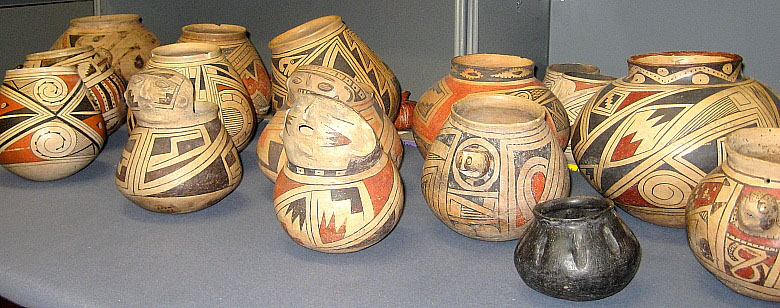
Casas Grandes, a society that covered much of Northwestern Mexico and the Southwestern United States during 1200 AD to 1450 AD,is very unique to its surrounding Mesoamerican societies. Most of these other cultures, for example the Maya, seem to deemphasize the power of women in both aspects of reproduction and also their contributions to society and ritual. The human effigies found in the Casas Grandes areas seem to accurately represent human activities and different individuals or supernatural/mythical beings, with reference to important women participation in society. Christine and Todd VanPool found significant differences in posture, body size, and body decoration between both male and female genders and two other "in betweens." Some distinguishing features happen to be the exaggeration of primary and secondary sex characteristics of males and females and the activities (very often related to biological sex) portrayed by the humans in the vessels.
All of the males in these effigies are identified as "smokers" which indicates that they could be smoking hallucinogens which would induce a trance used by shamans to travel between the worlds.
Many of the vessels that portray women contain a bird motif that is also associated with the shamanic journey. This bird is said to be a guardian animal that helps the shaman through the journey between the material and spiritual worlds. An interpretation is that the female, because of her association with the bird, is a caregiver and acts as a guardian of the shaman's spirit and physical body during the shamanic rituals and transformations.

The VanPools make a distinction of the people of the Casas Grandes that their society had aspects of gender dualism and that the genders complemented each other. The horned snake is associated with males while the macaw head is associated with women - the shaman effigy has both of these symbols which can be viewed as gender complementarity. Although the snake and the bird can be seen as masculine and feminine symbols respectively, they are not in opposition of each other. Males and females reflect a "unified cosmological structure based on balance between feminine and masculine" (VanPool 2006).
The human effigies elude to the activities that both men and women performed. Even more importantly, grave goods found at these sites "did not reflect a sexual division of labor or systematic differences in gender based statuses" (VanPool 2006). The fact that the women portrayed in the vessels have accentuated sexual characteristics suggests that fertility in women could have been just as important as shamanism.

As we can see from the explicit gender symbolism, gender was an important aspect of social life in Casas Grandes. However, the complementarity in gender creates an ideological equality between the two. It is important to view gender not as solely social identity but as a social structure.
With the Moche, we have discovered the role of women and the social roles that they have taken on, especially the Priestess seen in the recurring sacrifice scene of their iconography. The recurring themes and iconography of Moche ceramics occurs in the Casas Grandes society, as well. Although it may not be as clear that distinct women held positions of power, a part of their gender was not only in the shamans, but they did take part in the rituals of the society, which we see with the participation of women in the sacrifice scene. With a dualistic complimentary society between females and males and birds and serpents, women did hold power in that they were the guardians of the shamans on their spiritual travels. The emphasis of their importance is obvious and the society benefited from their complementarity in creating the social structure of class and differentiation in Casas Grandes.
References
Gender in Middle Range Societies: A Case Study in Casas Grandes Iconography
American Antiquity
Vol. 71, No. 1 (Jan., 2006), pp. 53-75
Vol. 71, No. 1 (Jan., 2006), pp. 53-75
Published by: Society for American Archaeology
The Shaman-Priests of the Casas Grandes Region, Chihuahua, Mexico
American Antiquity
Vol. 68, No. 4 (Oct., 2003), pp. 696-717
Vol. 68, No. 4 (Oct., 2003), pp. 696-717
Published by: Society for American Archaeology